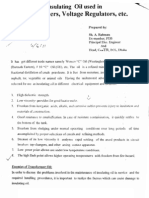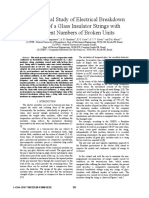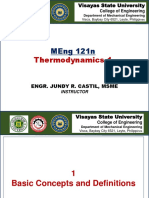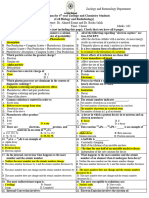At a glance
Powered by AI
The document discusses the insulation design process of power transformers to withstand operational voltages and transient overvoltages from the power system. The design aims to pass factory acceptance dielectric tests which simulate different overvoltage conditions.
1
Advanced Research Workshop on Transformers.
28 -30 October 2013
. Baiona– Spain
ARWtr
2013
AC Insulation Design of Power Transformers
Álvaro PORTILLO LAURINO
Transformer Consultant Brenda 5920, Montevideo, CP 11400, Uruguay Phone: (+598) 26007982, e-mail: acport@adinet.com.uy
Abstract
—
The insulation design of power transformers is focused in withstand the operational voltages and the different tests defined by standards trying to represent the different overvoltages conditions that the power system can impose to the transformer. Define an insulation structure implies define the electrodes geometry, the proper insulating materials used in each transformer part, the voltage distribution inside the transformer for each test, the electrical stress produced in the insulating materials for these voltages and finally be sure that this electric stress in each point are less than the admissible dielectric strength of the material placed in this point. In this work we will give an overview of the complete insulation design process of high voltage "core-type" power transformers operated in AC networks for engineers involved in design review tasks.
Keywords
— power transformers, over voltages in service, dielectric tests, AC design methodology
I.
I
NTRODUCTION
The power transformers in electric networks are subjected permanently to continuously operating voltages and sometimes to transient overvoltage phenomena caused by faults, switching operations or lightning. To probe his ability to work for many years in permanent and transient voltage service conditions the transformers are subjected to factory acceptance dielectric tests, trying to represent in these tests the different conditions that the power system can impose to the transformer. This tests are the result of more than 100 years of experience and is generally accepted that if a transformer successfully passes these tests they have a very high probability of work for many decades in service without dielectric problems. The challenge for the transformer designer is define an insulation structure which comply with the dielectric tests. The purpose of insulation of a transformer is to isolate parts or electrodes at different potentials from one another but the design of an insulation structure is not only define this distances inside the transformer. Previous to this is necessary to define completely the geometry and number of insulation barriers between windings and between windings and ground, the insulation material type best suited for each part of the transformer, the thickness of the conductor insulation, if is necessary or not the use of static end rings in the windings, the type of winding (interleaved or not), etc.. These definitions have a big influence in the voltage distribution inside the transformer and in the electric fields that appears during the dielectric tests. Once the material types and geometry is completely defined voltage distributions inside the windings according to the test voltages and to the corresponding winding connection during test are calculated. While for AC voltages (50 to 200 Hz) the distribution follows linearly the number of turns and can be calculated very precisely, the calculation of impulse voltage distribution requires the simulation of the transformer by means of an equivalent circuit consisting of lumped R, L and C elements. Then with this voltage distribution using numerical methods (like Finite Elements Method) is possible to calculate the electric field or electrical stress in each point inside the transformer. This electrical stress must be less than the admissible dielectric strength of the insulating material used in this point for this test condition. If not, the insulation design is modified and verified again, and this procedure iteratively must leads to an optimised solution. In the oil-paper insulation system used in transformers the dielectric strength of the insulation arrangement is principally determined by the dielectric strength of the oil. The solid insulation is used to subdivide long oil gaps into smaller ones with higher dielectric strength. The designer task is evaluate the oil gaps created by the
2
Advanced Research Workshop on Transformers.
28 -30 October 2013
. Baiona– Spain
ARWtr
2013
solid insulation barriers as well as the interfaces regions (solid-liquid) which are not parallel to equipotential lines. The manufacturers have experimental developed curves of low probability electric fields for puncture and creepage breakdown and partial discharges (PD) inception for the usual insulating materials and normally the design is defined in a way that the test stress does not exceed the PD inception values of the insulating materials. Finally the success of the dielectric design depends on select high quality insulating materials with narrow dimension tolerances and shape stability and applying adequate stabilization, drying and impregnation processes to the insulation materials.
II.
T
RANSFORMER
I
NSULATIONS
The transformer insulations are usually classified in external or major insulations and internal or minor insulations. External or major insulations include principally insulations outer the windings:
•
winding to winding (gaps between windings)
•
phase to phase (Fig.1)
•
windings to ground: to core legs, to core yokes (Fig.2) and to tank
•
winding leads: connections between windings, connections from windings to bushings (Fig.3), connections from windings to OLTC (Fig.4), etc.
Figure 1 Figure 2 Figure 3 Figure 4
3
Advanced Research Workshop on Transformers.
28 -30 October 2013
. Baiona– Spain
ARWtr
2013
Internal or minor insulations include principally insulations inside the windings:
•
conductor to conductor (Fig.5)
•
section to section: axially along windings (Fig.7 and Fig.8)
•
layer to layer
Figure 5 Figure 6
Figure 7 Figure 8
The previous figures show other essential elements in order to achieve a good dielectric design:
•
Angle caps (Fig.5)
•
Angle rings (Fig.6)
•
Static end rings (Fig.3 and Fig.8)
•
Internal surge arresters (Fig.2)
III.
D
IELECTRIC
T
ESTS
The transformers during operation are subject continuously to operating voltages and occasionally to overvoltages. The overvoltages occurring in the power systems can be divided into lightning overvoltages (aperiodic voltage waves with duration of one to tens of microseconds), switching overvoltages (damped oscillatory voltage waves with duration up to thousands of microseconds), and temporary overvoltages (lasting for few minutes) at or close to the power frequency. Prior to delivery, at the factory dielectric acceptance tests [1], transformers must overcome successfully several tests that simulate the permanent and transient conditions in service:
4
Advanced Research Workshop on Transformers.
28 -30 October 2013
. Baiona– Spain
ARWtr
2013
•
The
applied voltage test
at industrial frequency (50 or 60 Hz) is intended to verify the insulation withstand to operational voltage and to temporary overvoltages. With the applied voltage test the withstand strength of the external insulations (winding to winding and windings to earth) is verified. In this test there is not turn-to-turn voltage.
•
The
Induced voltage test
(short and long duration) at industrial frequency (between 100 to 200 Hz) is intended to verify the insulation withstand to operational voltage and to temporary overvoltages. With the induced voltage test we verified principally the internal insulations (turn to turn, section to section) and also external insulations (phase to phase, winding to winding and windings to earth). The long duration induced voltage test with PD measurement is intended to verify that the transformer will be free of partial discharges under normal operating conditions.
•
The
Switching impulse test
is intended to verify the capability of insulation to withstand slow rise time (greater than 100 µs) transient voltages typically associated with switching operations in service. With this test the internal and external insulations are verified to switching transients. The fundamental test wave frequency is in the order of 2.5 kHz.
•
The
Lightning impulse test
(full wave and chopped wave) is intended to verify the insulation withstand to fast rise time (around 1 µs) transients overvoltages occurring in the power system as a result of lightning strikes. With this test the internal and external insulations are verified to lightning transients. The fundamental test wave frequency is in the order of 250 kHz. For each of this tests, it's necessary to determine the distribution of voltage inside the transformer coils. Once these voltages are determined the electric fields in the insulation materials during these tests are calculated. The design of the different insulations inside the transformer is decided by one or more of these test levels. The section to section insulation is generally decided by impulse stresses, whereas the end insulation (between windings and yokes) may get predominantly decided by the power frequency test voltages. The turn to turn insulation (conductor insulation) is decided by either the impulse stress or working voltage stress.
IV.
V
OLTAGE
D
ISTRIBUTION IN
W
INDINGS
The distribution of voltage to ground along the coils (Fig.9a), for the different tests, is illustrated in the following figures: F
igure 9a Figure 9b Figure 9c Figure 9d
Fig.9b shows the distribution of voltage in the applied voltage test (not turn-to-turn voltage), Fig.9c shows the distribution of voltage in the induced voltage test (voltage inductively distributed, proportional to the number of turns, through all windings) and Fig.9d shows the distribution of voltage in the atmospheric impulse test (oscillating voltages that produces non-uniform stresses in winding under test). In the atmospheric impulse test the voltage distribution depends of the capacitances and inductances (self and mutual) of the windings. The initial voltage distribution inside the windings is capacitive and at the end of the transient this voltage distribution is inductive. During the transient the voltage in each point of the winding is oscillatory with frequencies equal to the natural frequencies of the transformer and with a damping depending of the transformer losses.





























































































